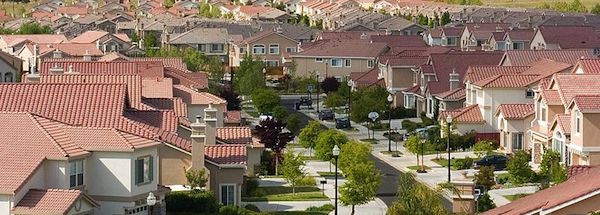Over at Mere O, Keith Miller has been kind enough to respond to a piece the FF editors published about Anthony Bradley’s praise of ordinary Christianity. In his post, Bradley lamented that “radical” or “missional” Christianity was obscuring the need for basic, everyday Christianity. He linked this misplaced zeal of “radical Christianity” to the anti-suburbs movement. We responded by agreeing in part with Bradley, but noted that “there’s ordinary, and then there’s total capitulation to contemporary American norms.” Therefore, “some forms of cultural resistance should be universal, because some aspects of ‘normal’ life in America are deeply unChristian.” We urged, as a part of this effort, resistance to the cultural language of the suburbs.
In his response, Miller suggests that most of the arguments offered against the suburbs are transparently weak:
Here are a few of the most prominent Christian objections to living in the suburbs. How many of them hold up to even a slight bit of scrutiny?
- Suburbs are inauthentic: I confess to not quite understanding what this means. Yes, suburban things are often newer and feature less exposed brick, but how is that a moral argument?
- Suburbs are consumeristic: No more than large cities.
- Suburbs are morally repressive: Wait, overt exhibition of immorality is a good thing?
- Suburbs lack diversity: The most diverse places in the country are suburbs.
Because these arguments are so weak, Miller believes, there must be something else animating the rise of anti-suburban Christianity. He suggests, on the one hand, that it’s mere political prejudice (“Suburbs are full of a lot of Evangelicals who vote Republican: Oh, wait, now we are getting somewhere…”) or some sort of uncritical adoption of a secular belief: “Do we have a biblically grounded objection rooted in our personal experiences, or have we merely baptized a secular prejudice and called it Christian ethics?” Earlier he writes, “Some of the modern rejection of suburbia now features argumentation about carbon footprints and climate change. But that is largely a retrofitting of the old aesthetic prejudice with scientific-sounding rhetoric.”
There’s a lot of interesting assumptions embedded in those last two quotes, some of which I will unpack below. But it seems odd for Miller to call our anti-suburban stance a “secular prejudice,” when, in fact, it’s our contention that the suburbs are a secular form, the secular world at, perhaps, its most visible. Even odder is his total failure to address the most convincing critique against the suburbs. In our first post, we linked to this piece by architect Will Seath that appeared in our winter print issue. In it the author argues that the suburbs are harmful because they structurally separate out the various areas of our lives. We worship, work, and live in different places. Seath writes:
Take for example the working class Chicago neighborhood, centered on the Catholic parish St. Nicholas of Tolentine, profiled in Alan Ehrenhalt’s book The Lost City. The parish territory covered about an eight-by-eight square of city blocks with fifteen thousand total residents—similar in size to the typical ancient Greek city-state. Most people belonged to St. Nick’s parish and knew each other through the church and other neighborhood associations. Families lived in bungalows with front porches and small yards, close to the street and the next-door neighbors. Locally owned groceries, stores, and banks within walking distance of every neighborhood home served each family’s needs and provided jobs. Children played on the street as if it were the neighborhood living room, and each troublemaker understood that any passing parent had a right to lay down the law.
The church was both literally and figuratively the center of the neighborhood. Its pulpit and parish school—as well as the parents who were brought up with these institutions—were charged with teaching right from wrong. The authority of the church, school, and family in this neighborhood built the bridges between the morally untutored man and his potential for holiness—his life of goodness. The prominence of the neighborhood’s religious and civic institutions and its relative density were an ideal representation of Aristotle’s communitarian values and of his concern for communities that pursue and share in activities of goodness. The example of St. Nick’s parish was largely typical of most American small towns and urban neighborhoods until the first half of the 20th century. Though particular neighborhoods may have been more-or-less exclusively populated by an economic or ethnic group, the basic character of the urban life was common to most neighborhoods.
In contrast:
The suburbs came to represent those habits of materialism and isolation. Middle-class families left urban neighborhoods for larger, more secluded homes on the city outskirts, where driveways pushed homes away from the street and garages replaced the semi-public realm of front porches. Few suburbs had a clear neighborhood center. For the first time, it was easy and inexpensive to live, work, shop, learn, and pray in places that were miles apart. Because of the automobile, communities could now be physically separated from deeply rooted social bonds, places of worship, and civic institutions.
This is not a new critique. Take this post at Front Porch Republic (“By contrast [to the front porch], the patio reflected both new settlement patterns and the increasing desire for privacy and withdrawal from interaction with one’s neighbors”), or this one at Public Discourse (“sprawl injures the common good in three inter-related ways: as the primary means by which both wealth and poverty are physically concentrated and isolated; by separating people according to income, age, and race; and, perhaps most importantly, by failing to provide a genuinely public realm shared by all”) or this FF blog post by Jake Meador (“First, the structure of our lives in the USA today makes friendship increasingly unlikely. Most of us…spend several hours commuting”).
William Stuntz’s masterful work The Collapse of American Criminal Justice traces just one of many practical consequences of the suburbs arrangement: the decline of local control over the criminal justice system gave us horrible crime policy. He writes:
The detached masters of today’s urban criminal justice systems have less to lose from mismanagement. To the suburban voters, state legislators, and state and federal judges whose decisions shape policing and punishment on city streets, criminal justice policies are political symbols or legal abstractions, not questions the answers to which define neighborhood life. If things go well, the benefits are felt by the residents of high-crime neighborhoods, not by the government officials who make the relevant decisions. If things go badly, the same residents of crime-ridden communities bear the cost. Decisionmakers who neither reap the benefits of good decisions, nor bear the cost of bad ones, tend to make bad ones. Both excessive lenity and excessive severity come naturally to a system rule by voters who see neither crime nor punishment up close.
With all this material out there, why would Miller pass over this critique entirely, in order to claim that there’s something deeper or more malignant going on in anti-suburban Christianity?
But I suspect our real disagreement with Miller goes much deeper than the discrete issue of whether the suburbs should be praised or dammed. It goes to the heart of many of the issues American Christians as a whole are currently thinking through. I want to go back to the two quotes from Miller I put above:
Some of the modern rejection of suburbia now features argumentation about carbon footprints and climate change. But that is largely a retrofitting of the old aesthetic prejudice with scientific-sounding rhetoric….Do we have a biblically grounded objection rooted in our personal experiences, or have we merely baptized a secular prejudice and called it Christian ethics?
Here are some assumptions embedded in these words:
1. Aesthetic prejudice is not a valid guide to policy, the common good, or intellectual discernment
2. Adopting secular prejudices should also be viewed with suspicion
3. The best guide in all cases to Christian thinking about the common good are “biblically-grounded” objections “rooted in our personal experience”
All three of these assumptions are worrisome, and speak to a kind of approach to Christianity that I worry has done more harm than good. This post is already long enough, so I don’t have time to address each of these in full, but here’s some initial thoughts.
1. Aesthetic prejudices matter: “You remember that lovely passage in which Plato describes how a young Greek should be educated, and with what insistence he dwells upon the importance of surroundings, telling us how the lad is to be brought up in the midst of fair sights and sounds, so that the beauty of material things may prepare his soul for the reception of the beauty that is spiritual. Insensibly, and without knowing the reason why, he is to develop that real love of beauty which, as Plato is never weary of reminding us, is the true aim of education. By slow degrees there is to be engendered in him such a temperament as will lead him naturally and simply to choose the good in preference to the bad, and, rejecting what is vulgar and discordant, to follow by fine instinctive taste all that possesses grace and charm and loveliness. Ultimately, in its due course, this taste is to become critical and self-conscious, but at first it is to exist purely as a cultivated instinct, and ‘he who has received this true culture of the inner man will with clear and certain vision perceive the omissions and faults in art or nature, and with a taste that cannot err, while he praises, and finds his pleasure in what is good, and receives it into his soul, and so becomes good and noble, he will rightly blame and hate the bad, now in the days of his youth, even before he is able to know the reason why’: and so, when, later on, the critical and self-conscious spirit develops in him, he ‘will recognise and salute it as a friend with whom his education has made him long familiar.'” -Oscar Wilde, The Critic as Artist
2. I understand a kind of de facto suspicion of the secular. There’s a form this can take, in, for example, the writings of Stanley Hauweras, that I am quite sympathetic with. But I don’t think that’s quite the form that Miller is drawing upon here. A kind of aversion to Christian adoption of secular thinking is behind a lot of the more harmful facets of American Christian thought (e.g. continued skepticism of evolution). I am not saying Miller himself is a creationist, only that the kind of language he employs here gives comfort to that kind of thinking. All truth is one, and we shouldn’t hesitate to adopt something just because it has a secular provenance.
3. I do not believe that every position Christians ought to hold can be grounded in some discrete Biblical text. An ethics grounded in proof-texting the Bible will always be thin, watered-down, and incomplete. Christians need to engage with the breadth of human learning, and an argument can be quite persuasive and intellectually binding on a Christian even if it does not once mention the Bible. Indeed, I believe American Christians have perhaps gotten anyway with adopting some profoundly unChristian practices precisely because they’ve taken cover behind an individualistic, proof-texting mentality. The Bible doesn’t condemn malls, therefore it’s acceptable for Christians to accept malls uncritically.
I should note, in closing, that the suburbs are really just a cultural symbol of the larger point we were trying to make. That point was: Bradley was right to suggest that we need more ordinary, God-loving, everyday Christianity. We don’t all have to be radically missional in the sense that some evangelicals promote. But we should not mistake the normal cultural standards of 21st century American life for “ordinary” life. By the standards of both grace and nature, ordinary American life, in many ways, falls far short of what ordinary life should look like. Of course, this gap will always be with us, courtesy of the Fall, but that doesn’t mean that certain cultural arrangements can’t make it bigger or smaller. The prominence of the suburbs is just one example of how the structure of normal 21st century American life is in deep need of reformation.
[Image of San Jose suburbs from Wikipedia]













